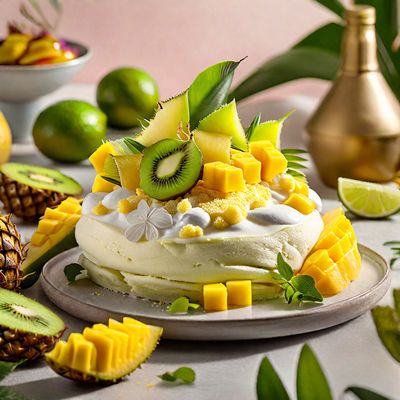
Ingredient
Dried bananas
Nature's Sweet and Chewy Delight: Dried Bananas
Dried bananas are made by removing the moisture from fresh bananas, resulting in a concentrated and preserved form of the fruit. They have a soft and chewy texture with a slightly sticky feel. The color of dried bananas ranges from golden yellow to deep brown, depending on the ripeness of the fruit. They offer a naturally sweet flavor with hints of caramel and tropical notes. Dried bananas are a convenient and shelf-stable alternative to fresh bananas, making them a popular choice for snacking, baking, and adding to trail mixes or granola.
Origins and history
Bananas are believed to have originated in Southeast Asia and have been cultivated for thousands of years. The drying process was developed as a means of preserving bananas for longer periods, especially in regions where fresh bananas were not readily available. Dried bananas have been consumed in various cultures throughout history, including in ancient Egypt and China. Today, they are enjoyed worldwide and are particularly popular in tropical regions.
Nutritional information
Dried bananas are a good source of dietary fiber, potassium, and vitamin C. They are also low in fat and contain natural sugars. A 1-ounce (28g) serving of dried bananas provides approximately 100 calories.
Allergens
Dried bananas are not known to be a common allergen, but individuals with a latex allergy may experience cross-reactivity and should exercise caution.
How to select
When selecting dried bananas, look for ones that are plump, slightly soft, and free from any signs of mold or discoloration. Avoid those that appear overly dry or have a hard texture, as they may be stale or past their prime.
Storage recommendations
Store dried bananas in an airtight container in a cool, dry place away from direct sunlight. They can also be stored in the refrigerator or freezer for extended shelf life.
How to produce
To produce dried bananas at home, slice ripe bananas into thin rounds and arrange them in a single layer on a baking sheet. Place the baking sheet in an oven set to the lowest temperature (around 140°F or 60°C) and allow the bananas to dry for several hours, flipping them occasionally, until they are dry and chewy.
Preparation tips
Dried bananas can be enjoyed as a standalone snack or used in various culinary applications. They can be added to breakfast cereals, oatmeal, or yogurt for a natural sweetness and texture. Dried bananas can also be incorporated into baked goods such as muffins, bread, or cookies. For a tropical twist, rehydrate dried bananas by soaking them in warm water or fruit juice before using them in recipes.
Culinary uses
Dried bananas are commonly used in baking, trail mixes, granola bars, and energy balls. They can also be blended into smoothies or used as a topping for ice cream and yogurt.
Availability
Dried bananas are widely available in grocery stores, supermarkets, and online retailers. They are commonly produced in tropical regions such as Southeast Asia, South America, and Africa.
More ingredients from this category

Mixed dried fruits
Nature's Sweet Medley: Exploring the World of Mixed Dried Fruits

Dried pears
The Sweet Essence of Preserved Pears

Dried figs
Nature's Sweet Gems: Dried Figs

Dried apples
The Sweet Essence of Sun-Dried Apples

Dried dates
Nature's Sweet Gems

Chocolate coated dried fruit
Decadent Delights: Chocolate Coated Dried Fruit

Fruit chips
Crispy Delights: Fruit Chips

Dried mangoes
The Sweet and Tangy Delight

Dried apricots
The Golden Gems: Unveiling the Delights of Dried Apricots

Dried prunes
Nature's Sweet and Tangy Gems

Dried vine fruits (raisins etc.)
Nature's Sweet Gems
Recipes using Dried bananas » Browse all

Tuvaluan Coconut Jam Cake
Tropical Delight: Tuvaluan Coconut Jam Cake

Fool's Gold Paratha
Golden Paratha Delight: A Fusion of American Indulgence and Indian Flavors

Grilled Banana Skewers with Caramel Sauce
Smoky Sweet Delight: Grilled Banana Skewers with Caramel Sauce

Jiangxi-style Banana Soup
Savory Banana Delight: Jiangxi-style Soup with a Twist

Antiguan and Barbudan Rujak Cuka
Tropical Fruit Salad with Tangy Dressing

Rwandan-style Black Sticky Rice Porridge
Umugati wa Mbiribiri: A Rwandan Delight of Black Sticky Rice Porridge

Coconut and Banana Kolak
Tropical Delight: Coconut and Banana Kolak

Haitian Spiced Bread
Caribbean Delight: Haitian Spiced Bread

Djenkoume with a Caribbean Twist
Caribbean Spiced Cornmeal Porridge

Haitian Banana Delight
Tropical Bliss: Haitian Banana Delight

Brazilian-style Focaccia
Tropical Delight Focaccia: A Brazilian Twist on an Italian Classic

Caribbean-Inspired Tropical Pavlova
Island Delight: Caribbean-Inspired Tropical Pavlova